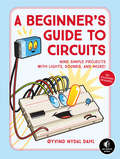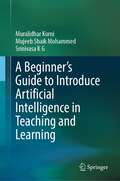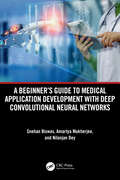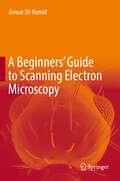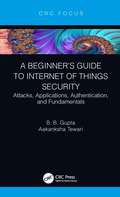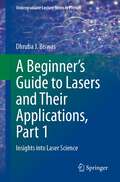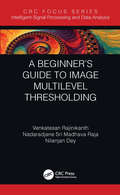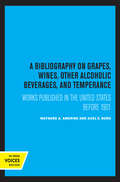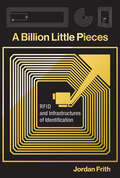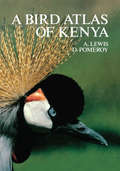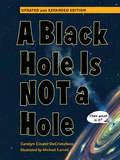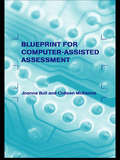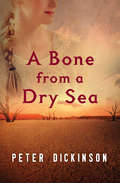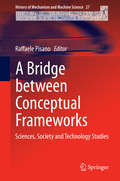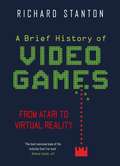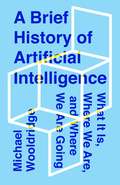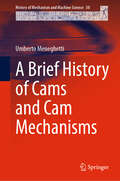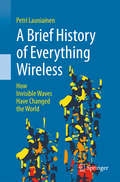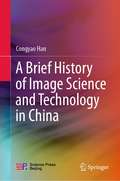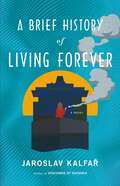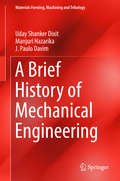- Table View
- List View
A Beginner's Guide to Circuits: Nine Simple Projects with Lights, Sounds, and More!
by Oyvind Nydal DahlA Beginner's Guide to Circuits is the perfect first step for anyone ready to jump into the world of electronics and circuit design. After finishing the book's nine graded projects, readers will understand core electronics concepts which they can use to make their own electrifying creations!First, you'll learn to read circuit diagrams and use a breadboard, which allows you to connect electrical components without using a hot soldering iron! Next, you'll build nine simple projects using just a handful of readily available components, like resistors, transistors, capacitors, and other parts. As you build, you'll learn what each component does, how it works, and how to combine components to achieve new and interesting effects.By the end of the book, you'll be able to build your own electronic creations. With easy-to-follow directions, anyone can become an inventor with the help of A Beginner's Guide to Circuits!Build These 9 Simple Circuits! * Steady-Hand Game: Test your nerves using a wire and a buzzer to create an Operation-style game! * Touch-Enabled Light: Turn on a light with your finger! * Cookie Jar Alarm: Catch cookie thieves red-handed with this contraption. * Night-Light: Automatically turn on a light when it gets dark. * Blinking LED: This classic circuit blinks an LED. * Railroad Crossing Light: Danger! Don't cross the tracks if this circuit's pair of lights is flashing. * Party Lights: Throw a party with these charming string lights. * Digital Piano: Play a tune with this simple synthesizer and learn how speakers work. * LED Marquee: Put on a light show and impress your friends with this flashy finale.<
A Beginner's Guide to Introduce Artificial Intelligence in Teaching and Learning
by Srinivasa K G Muralidhar Kurni Mujeeb Shaik MohammedThis book reimagines education in today’s Artificial Intelligence (AI) world and the Fourth Industrial Revolution. Artificial intelligence will drastically affect every industry and sector, and education is no exception. This book aims at how AI may impact the teaching and learning process in education. This book is designed to demystify AI for teachers and learners. This book will help improve education and support institutions in the phenomena of the emergence of AI in teaching and learning. This book presents a comprehensive study of how AI improves teaching and learning, from AI-based learning platforms to AI-assisted proctored examinations. This book provides educators, learners, and administrators on how AI makes sense in their everyday practice. Describing the application of AI in ten key aspects, this comprehensive volume prepares educational leaders, designers, researchers, and policymakers to effectively rethink the teaching and learning process and environments that students need to thrive. The readers of this book never fall behind the fast pace and promising innovations of today’s most advanced learning technology.
A Beginner's Guide to Medical Application Development with Deep Convolutional Neural Networks
by Nilanjan Dey Amartya Mukherjee Snehan BiswasThis book serves as a source of introductory material and reference for medical application development and related technologies by providing the detailed implementation of cutting-edge deep learning methodologies. It targets cloud-based advanced medical application developments using open-source Python-based deep learning libraries. It includes code snippets and sophisticated convolutional neural networks to tackle real-world problems in medical image analysis and beyond.Features: Provides programming guidance for creation of sophisticated and reliable neural networks for image processing. Incorporates the comparative study on GAN, stable diffusion, and its application on medical image data augmentation. Focuses on solving real-world medical imaging problems. Discusses advanced concepts of deep learning along with the latest technology such as GPT, stable diffusion, and ViT. Develops applicable knowledge of deep learning using Python programming, followed by code snippets and OOP concepts. This book is aimed at graduate students and researchers in medical data analytics, medical image analysis, signal processing, and deep learning.
A Beginners' Guide to Scanning Electron Microscopy
by Anwar Ul-HamidThis book was developed with the goal of providing an easily understood text for those users of the scanning electron microscope (SEM) who have little or no background in the area. The SEM is routinely used to study the surface structure and chemistry of a wide range of biological and synthetic materials at the micrometer to nanometer scale. Ease-of-use, typically facile sample preparation, and straightforward image interpretation, combined with high resolution, high depth of field, and the ability to undertake microchemical and crystallographic analysis, has made scanning electron microscopy one of the most powerful and versatile techniques for characterization today. Indeed, the SEM is a vital tool for the characterization of nanostructured materials and the development of nanotechnology. However, its wide use by professionals with diverse technical backgrounds—including life science, materials science, engineering, forensics, mineralogy, etc., and in various sectors of government, industry, and academia—emphasizes the need for an introductory text providing the basics of effective SEM imaging.A Beginners’ Guide to Scanning Electron Microscopy explains instrumentation, operation, image interpretation and sample preparation in a wide ranging yet succinct and practical text, treating the essential theory of specimen-beam interaction and image formation in a manner that can be effortlessly comprehended by the novice SEM user. This book provides a concise and accessible introduction to the essentials of SEMincludes a large number of illustrations specifically chosen to aid readers' understanding of key conceptshighlights recent advances in instrumentation, imaging and sample preparation techniquesoffers examples drawn from a variety of applications that appeal to professionals from diverse backgrounds.
A Beginner’s Guide to Internet of Things Security: Attacks, Applications, Authentication, and Fundamentals
by B. B. Gupta Aakanksha TewariA Beginner’s Guide to Internet of Things Security focuses on security issues and developments in the Internet of Things (IoT) environment. The wide-ranging applications of IoT, including home appliances, transportation, logistics, healthcare, and smart cities, necessitate security applications that can be applied to every domain with minimal cost. IoT contains three layers: application layer, middleware layer, and perception layer. The security problems of each layer are analyzed separately to identify solutions, along with the integration and scalability issues with the cross-layer architecture of IoT. The book discusses the state-of-the-art authentication-based security schemes, which can secure radio frequency identification (RFID) tags, along with some security models that are used to verify whether an authentication scheme is secure against any potential security risks. It also looks at existing authentication schemes and security models with their strengths and weaknesses. The book uses statistical and analytical data and explains its impact on the IoT field, as well as an extensive literature survey focusing on trust and privacy problems. The open challenges and future research direction discussed in this book will help to further academic researchers and industry professionals in the domain of security. Dr. Brij B. Gupta is an assistant professor in the Department of Computer Engineering, National Institute of Technology, Kurukshetra, India. Ms. Aakanksha Tewari is a PhD Scholar in the Department of Computer Engineering, National Institute of Technology, Kurukshetra, India.
A Beginner’s Guide to Lasers and Their Applications, Part 1: Insights into Laser Science (Undergraduate Lecture Notes in Physics)
by Dhruba J. BiswasThis two-volume book provides an enriching insight into the laser, covering different types of lasers, the basic science behind the technology, their role at the cutting-edge of current scientific research, and their wide-ranging applications. With just high school physics as a prerequisite and favoring qualitative yet scientifically sound explanations over high-level mathematics, this book is aimed at a broad spectrum of readers in physics, chemistry, engineering, medicine, and biology. Its engaging and lucid presentation is enhanced with plenty of illustrations, making the world of the laser accessible to undergraduate students in the sciences and any other inquisitive readers with high school physics under their belts. Furthermore, the text is often laced with anecdotes, picked from history, that are bound to pique the minds of the readers. It is ideal for self-study or as a complement to courses on optics and optoelectronics. This volume, Part 1 of 2, explains the fundamentals of optics, what a laser is, how it works, and what is unique about the light it emits, from fundamental quantum theory through population inversion and cavity to common laser types. It is followed by Part 2 which depicts the many advances in science enabled by the laser, including spectroscopy, nonlinear optics, optical cooling and trapping, and optical tweezers, among many others, and provides a glimpse into the ways that the laser affects our lives via its uses in medicine, manufacturing, the nuclear industry, energy, defence, communication, ranging, pollution monitoring, art conservation, fashion, beauty, and entertainment.
A Beginner’s Guide to Learning Analytics (Advances in Analytics for Learning and Teaching)
by Srinivasa K G Muralidhar KurniThis book A Beginner’s Guide to Learning Analytics is designed to meet modern educational trends’ needs. It is addressed to readers who have no prior knowledge of learning analytics and functions as an introductory text to learning analytics for those who want to do more with evaluation/assessment in their organizations. The book is useful to all who need to evaluate their learning and teaching strategies. It aims to bring greater efficiency and deeper engagement to individual students, learning communities, and educators.Covered here are the key concepts linked to learning analytics for researchers and practitioners interested in learning analytics. This book helps those who want to apply analytics to learning and development programs and helps educational institutions to identify learners who require support and provide a more personalized learning experience. Like chapters show diverse uses of learning analytics to enhance student and faculty performance. It presents a coherent framework for the effective translation of learning analytics research for educational practice to its practical application in different educational domains. This book provides educators and researchers with the tools and frameworks to effectively make sense of and use data and analytics in their everyday practice. This book will be a valuable addition to researchers’ bookshelves.
A Beginner’s Guide to Multilevel Image Thresholding (Intelligent Signal Processing and Data Analysis)
by Nilanjan Dey Venkatesan Rajinikanth Nadaradjane Sri Madhava RajaA Beginner’s Guide to Image Multi-Level Thresholding emphasizes various image thresholding methods that are necessary for image pre-processing and initial level enhancement. Explains basic concepts and the implementation of Image Multi-Level Thresholding (grayscale and RGB images) Presents a detailed evaluation in real-time application, including the need for heuristic algorithm, the choice of objective and threshold function, and the evaluation of the outcome Describes how the image thresholding acts as a pre-processing technique and how the region of interest in a medical image is enhanced with thresholding Illustrates integration of the thresholding technique with bio-inspired algorithms Includes current findings and future directions of image multi-level thresholding and its practical implementation Emphasizes the need for multi-level thresholding with suitable examples The book is aimed at graduate students and researchers in image processing, electronics engineering, computer sciences and engineering.
A Bibliography on Grapes, Wines, Other Alcoholic Beverages, and Temperance: Works Published in the United States Before 1901 (UC Publications in Catalogs and Bibliographies #12)
by M. A. Amerine Axel E. BorgThis title is part of UC Press's Voices Revived program, which commemorates University of California Press’s mission to seek out and cultivate the brightest minds and give them voice, reach, and impact. Drawing on a backlist dating to 1893, Voices Revived makes high-quality, peer-reviewed scholarship accessible once again using print-on-demand technology. This title was originally published in 1996.
A Billion Little Pieces: RFID and Infrastructures of Identification (Infrastructures)
by Jordan FrithHow RFID, a ubiquitous but often invisible mobile technology, identifies tens of billions of objects as they move through the world.RFID (Radio Frequency Identification) is ubiquitous but often invisible, a mobile technology used by more people more often than any flashy smartphone app. RFID systems use radio waves to communicate identifying information, transmitting data from a tag that carries data to a reader that accesses the data. RFID tags can be found in credit cards, passports, key fobs, car windshields, subway passes, consumer electronics, tunnel walls, and even human and animal bodies—identifying tens of billions of objects as they move through the world. In this book, Jordan Frith looks at RFID technology and its social impact, bringing into focus a technology that was designed not to be noticed.RFID, with its ability to collect unique information about almost any material object, has been hyped as the most important identification technology since the bar code, the linchpin of the Internet of Things—and also seen (by some evangelical Christians) as a harbinger of the end times. Frith views RFID as an infrastructure of identification that simultaneously functions as an infrastructure of communication. He uses RFID to examine such larger issues as big data, privacy, and surveillance, giving specificity to debates about societal trends. Frith describes how RFID can monitor hand washing in hospitals, change supply chain logistics, communicate wine vintages, and identify rescued pets. He offers an accessible explanation of the technology, looks at privacy concerns, and pushes back against alarmist accounts that exaggerate RFID's capabilities. The increasingly granular practices of identification enabled by RFID and other identification technologies, Frith argues, have become essential to the working of contemporary networks, reshaping the ways we use information.
A Bird Atlas of Kenya
by Adrian LewisKenya, a country only the size of Texas, has one of the richest avifaunas in Africa. This atlas is an explanatory overview of Kenya's 1065 species, essential both to the birdwatcher as a means of finding birds and interpreting the significance of field observations, and to the ornithologist as a standard reference work.
A Black Hole is Not a Hole: Updated Edition
by Carolyn Cinami DeCristofanoA black hole isn't really a hole . . . is it? Get ready to S-T-R-E-T-C-H your mind with this beloved and best-selling science book. Updated with an all-new chapter about the first black-hole image ever!What are black holes, what causes them, and how the heck did scientists discover them? Acclaimed STEM writer Carolyn DeCristofano's playful text shares how astronomers find black holes, introduces our nearest black-hole neighbors, and provides an excellent introduction to an extremely complex scientific topic. Gorgeous space paintings supplement real telescopic images, and funny doodles and speech bubbles keep the content light and fun.
A Blueprint for Computer-Assisted Assessment
by Joanna Bull Colleen McKennaThe rapid development and integration of computer-assisted assessment (CAA) in mainstream post-compulsory educational institutions today make this an exciting and invaluable reference text. It provides a practical, research-based guide on a subject that is becoming increasingly important as educational assessment changes and grows.The book addresses theory and practice, offering a comprehensive evaluation of many key aspects of CAA such as: * question and test design, scoring and analysis, and feedback and integration with other assessment methods* the role of CAA in feedback processes* wider use of technology to support and enhance assessment* technical, operational and support issues.The authors present a lucid,balanced analysis of the strengths and weaknesses of CAA. This text will appeal to all those involved in higher or further education who wish to model their CAA systems on the best practice available.
A Bone from a Dry Sea
by Peter DickinsonOn a prehistoric shore, a young girl fights to help her tribe survive She is at home in the ocean, as comfortable in the water as she is on dry land. The child’s people have made their homes by the bay for as long as anyone can remember, diving for mussels and any other food the ocean will serve to them. They have no language; they have no names. Although they know love and jealousy and pride, they are not quite human—not yet. This child of the sea will show them the way. Two million years later, Vinny is visiting her father at an archaeological site in Africa when they discover the remains of that forgotten tribe of cliff dwellers. Across the ocean of time, these two young women will find a connection, an inexplicable bond that builds slowly but arrives with all the power of a tidal wave. This ebook features an illustrated personal history of Peter Dickinson including rare images from the author’s collection.
A Bridge between Conceptual Frameworks: Sciences, Society and Technology Studies (History of Mechanism and Machine Science #27)
by Raffaele PisanoThis book analyzes scientific problems within the history of physics, engineering, chemistry, astronomy and medicine, correlated with technological applications in the social context. When and how is tension between disciplines explicitly practised? What is the conceptual bridge between science researches and the organization of technological researches in the development of industrial applications? The authors explain various ways in which the sciences allowed advanced modelling on the one hand, and the development of new technological ideas on the other hand. An emphasis on the role played by mechanisms, production methods and instruments bestows a benefit on historical and scientific discourse: theories, institutions, universities, schools for engineers, social implications as well. Scholars from different traditions discuss the emergency style of thinking in methodology and, in theoretical perspective, aim to gather and re-evaluate the current thinking on this subject. It brings together contributions from leading experts in the field, and gives much-needed insight into the subject from a historical point of view. The volume composition makes for absorbing reading for historians, philosophers and scientists.
A Brief History Of Video Games
by Rich StantonA Brief History of Video Games describes and explains the remarkable evolution of interactive entertainment, from the demonstration of Nimrod in 1951 to full-body virtual reality in 2014. Video games are a technology-led medium and this book examines everything from the first wood-panelled Pong machines in California right up to the engineering masterpieces that now sit in countless homes, with brief stopovers for dead-ends like Philips CDi and early VR. Most importantly, it?s all about the games ? how these experiences have evolved from simple call-and-response mechanics into sophisticated, captivating worlds, responsive in just about every way to players.
A Brief History Of Video Games: From Atari to Virtual Reality (Brief Histories)
by Rich Stanton'Stanton writes with terrific verve and precision . . . his understanding of the seductive pleasures of gaming takes us right to its heart.'Maria Bustillos, Times Literary Supplement'The best overview book of the industry that I've read.'Andrew Liptak, io9From the first wood-panelled Pong machines in California to the masterpieces of engineering that now sit in countless homes all over the world, A Brief History of Video Games reveals the vibrant history and culture of interactive entertainment. Above all, this is a book about the games - how the experience of playing has developed from simple, repetitive beginnings into a cornucopia of genres and styles, at once utterly immersive and socially engaging. With full-colour illustrations throughout, it shows how technological advances have transformed the first dots and dashes of bored engineers into sophisticated, responsive worlds that are endlessly captivating. As thrilling and surprising as the games it describes, this is an indispensable read for anyone serious about the business of having fun.
A Brief History of Artificial Intelligence: What It Is, Where We Are, and Where We Are Going
by Michael WooldridgeFrom Oxford's leading AI researcher comes a fun and accessible tour through the history and future of one of the most cutting edge and misunderstood field in science: Artificial IntelligenceThe somewhat ill-defined long-term aim of AI is to build machines that are conscious, self-aware, and sentient; machines capable of the kind of intelligent autonomous action that currently only people are capable of. As an AI researcher with 25 years of experience, professor Mike Wooldridge has learned to be obsessively cautious about such claims, while still promoting an intense optimism about the future of the field. There have been genuine scientific breakthroughs that have made AI systems possible in the past decade that the founders of the field would have hailed as miraculous. Driverless cars and automated translation tools are just two examples of AI technologies that have become a practical, everyday reality in the past few years, and which will have a huge impact on our world.While the dream of conscious machines remains, Professor Wooldridge believes, a distant prospect, the floodgates for AI have opened. Wooldridge's A Brief History of Artificial Intelligence is an exciting romp through the history of this groundbreaking field--a one-stop-shop for AI's past, present, and world-changing future.
A Brief History of Cams and Cam Mechanisms (History of Mechanism and Machine Science #50)
by Umberto MeneghettiThis book offers a description of the evolution of cams and their uses from the Middle Ages to the present day, highlighting their contribution to the development of technology. Usually, in the history of technology the diverse types of machines are taken into account, but the importance of cams is not emphasized, which are often fundamental for the operation of such machines. In this book the focus is instead on cams, understood as important, and often essential, components of machines that have had significant importance in the development of technology. It treats technical aspects at a level easily accessible even to non-experts in mechanics and the various applications are illustrated with many figures. The book serves as a reference work for those interested in both the history of technology and machines in general, and it helps them deal with certain mechanical problems, even starting from solutions already obtained with cams and, perhaps, overcoming them with others suggested by current developments in technology.
A Brief History of Everything Wireless: How Invisible Waves Have Changed the World
by Petri LauniainenSince the discovery of electromagnetic waves less than 150 years ago, the application of wireless communications technology has not only revolutionized our daily lives, but also fundamentally changed the course of world history.A Brief History of Everything Wireless charts the fascinating story of wireless communications. The book leads the reader on an intriguing journey of personal triumphs and stinging defeats, relating the prominent events, individuals and companies involved in each progressive leap in technology, with a particular focus on the phenomenal impact of each new invention on society. Beginning at the early days of spark-gap transmitters, this tale touches on the emergence of radio and television broadcasting, as well as radio navigation and radar, before moving on to the rise of satellite, near-field and light-based communications. Finally, the development of wireless home networks and the explosive growth of modern cellular technologies are revealed, complete with a captivating account of their corresponding company histories and behind-the-scenes battles over standards.For those wishing to peek behind the magic curtain of friendly user interfaces and clever engineering, and delve further into various processes underlying the ubiquitous technology we depend upon yet take for granted, the book also contains special “TechTalk” chapters that explain the theoretical basics in an intuitive way.
A Brief History of High-Speed Rail
by Qizhou Hu Siyuan QuThis book introduces the basic knowledge, concepts, terms and development process of high-speed rail (HSR) and summarizes its main achievements at this stage. It mainly expounds the connotation of high-speed rail to readers from two different aspects of theory and technology. The book explains the development process of high-speed rail in terms of time: yesterday's wheel rail high-speed rail, today's maglev high-speed rail and tomorrow's super high-speed rail; and also spatially, making a comparative analysis of the development around the world.This book can be used as a reading material for scientific researchers, engineering technicians, management workers, teachers and students of colleges and universities as well as high-speed railfans.
A Brief History of Image Science and Technology in China
by Congyao HanThis book, within the vision of the study on the image history, clearly manifests the development of Chinese image science and technology of over 2000 years based on compendium, while having briefly sorted out expositions by scientists since ancient times in China, demonstrates the spiritual course, ideas of thinking and forms of life and reveales profound humane ideas, basis of sentiments and styles of the spirit featured by Chinese image culture. The historic outline of images is clear-cut along with authenticated inter-attestation for clues of images and texts. Historic facts concerning images are ecologically diversified, while historic documents about images are properly chosen, in addition to the integration between liberal arts and science and perfect combination between images and texts. Blessed with nice integration between images and texts, this book serves as reference to experts, scholars, undergraduates and postgraduates related to the study on image history, history of science and technology, study of history and news communication.
A Brief History of Living Forever: A Novel
by Jaroslav KalfarIn this &“ingenious, funny, and chilling&” novel (Publishers Weekly, starred review) from the author of Spaceman of Bohemia, two long-lost siblings risk everything to save their mother from oblivion in an authoritarian near-future America obsessed with digital consciousness and eternal life—a story that &“packs a walloping punch&” (Esquire). When Adéla discovers she has a terminal illness, she leaves behind her native Czech village for a chance at reuniting in America with Tereza, the daughter she gave up at birth, decades earlier. But the country Adéla experienced as a young woman, when she eloped with a filmmaker and starred in his cult sci-fi movie, has changed entirely. In 2030, America is ruled by an authoritarian government increasingly closed off to the rest of the world. Tereza, the star researcher for VITA, a biotech company hellbent on discovering the key to immortality, is overjoyed to meet her mother, with whom she forms an instant, profound connection. But when their time together is cut short by shocking events, Tereza must uncover VITA&’s alarming activity in the wastelands of what was once Florida, and persuade the Czech brother she&’s never met to join her in this odds-defying adventure. Narrated from the beyond by Adéla&’s restless spirit, A Brief History of Living Forever is a high-wire act of storytelling from a writer &“booming with vitality and originality,&” whose &“voice is distinct enough to leave tread marks&” (New York Times). By turns insightful, moving, and funny, the novel not only confirms Jaroslav Kalfař&’s boundless powers of invention but also exults in the love between a mother and her daughter, which neither space nor time can sever.&“Kalfař is a wise, rapturous, and original writer . . . Eloquent, heart-stunning, and rich in awe-inspiring prose.&” —San Francisco Chronicle &“Relentlessly inventive . . . His writing has the same hyperactivity and fidgety contempt for generic boundaries as that of the young Safran Foer.&” —The Guardian
A Brief History of Mechanical Engineering (Materials Forming, Machining and Tribology)
by J. Paulo Davim Uday Shanker Dixit Manjuri HazarikaWhat is mechanical engineering? What a mechanical engineering does? How did the mechanical engineering change through ages? What is the future of mechanical engineering? This book answers these questions in a lucid manner. It also provides a brief chronological history of landmark events and answers questions such as: When was steam engine invented? Where was first CNC machine developed? When did the era of additive manufacturing start? When did the marriage of mechanical and electronics give birth to discipline of mechatronics? This book informs and create interest on mechanical engineering in the general public and particular in students. It also helps to sensitize the engineering fraternity about the historical aspects of engineering. At the same time, it provides a common sense knowledge of mechanical engineering in a handy manner.
A Brief History of Nuclear Reactor Accidents: From Leipzig to Fukushima (Springer Praxis Books)
by Serge MarguetAre you afraid of a nuclear reactor accident? Should you be? This book will arm you with the scientific knowledge necessary to make a rational and informed opinion on the subject, without having to be an expert in nuclear physics. Written so that a non-specialist can easily approach the highly technical aspects, it looks at all significant nuclear reactor accidents since the dawn of the Atomic Age and brings to light many crucial details that rarely, if ever, appear in the general media. Serge Marguet, an internationally renowned expert in reactor physics, breaks down the must-know technical aspects of numerous nuclear reactor accidents throughout history — both famous and unknown — from the first ever nuclear accident in Leipzig to the Chernobyl explosion and, finally, the Fukushima affair and its most recent developments. With many high-quality photographs and diagrams, this book is essential reading for anyone concerned about nuclear safety, curious about nuclear reactors, or simply interested in the history — and future — of nuclear power.
